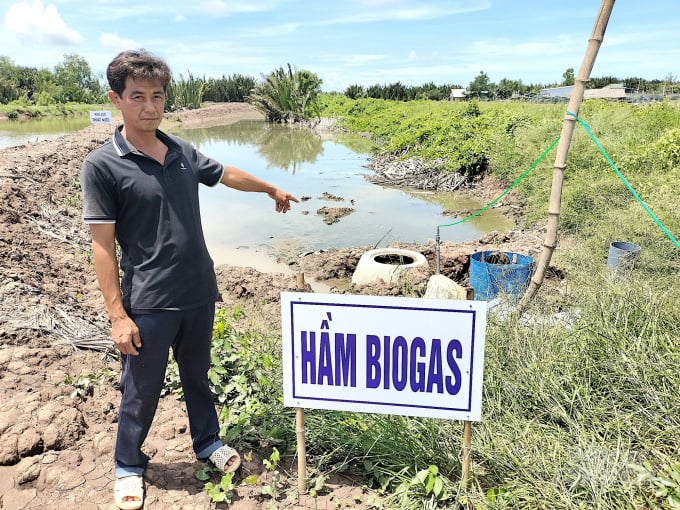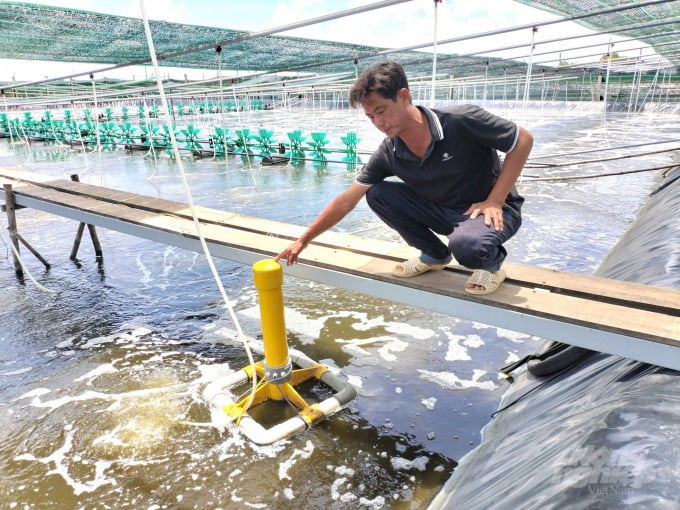November 26, 2025 | 19:32 GMT +7
November 26, 2025 | 19:32 GMT +7
Hotline: 0913.378.918
November 26, 2025 | 19:32 GMT +7
Hotline: 0913.378.918

Le Van Ben talked about the environmental effectiveness of biogas application. Photo: Minh Dam.
Recently, whiteleg shrimp farming in Tra Vinh Province has brought about high economic efficiency. However, climate change has seriously affected the environment of shrimp ponds.
To limit the negative effects, Tra Vinh Agricultural Extension Center has developed a two-stage technical project for intensive whiteleg shrimp farming, applying Industry 4.0 and biogas technologies for environmental treatment.
The objective is to raise large, quality seeds for commercial farming, limit disease, sustainably develop and improve the efficiency of white leg shrimp farming.
Prior to the implementation of the project, the center had conducted training for farmers on farming techniques, diary recording, technology application in high-density intensive shrimp culture and operating principle of biogas cellars in environmental protection.
The project has been piloted by two households: Nguyen Hoang Kim Dinh’s in Hiep My Tay Commune, Cau Ngang District (scale: 1ha) and Le Van Ben’s in Don Chau Commune, Duyen Hai District (scale: 1ha). The households have been installed with 2 sets of environmental monitoring and two biogas cellars.
The initial results reveal that the project has brought about high economic efficiency compared to traditional methods.
Having the same stocking density, the survival rate of the shrimp raised within the project reaches 94%, 24% higher than that raised with traditional methods. The weight of the shrimp has increased to 55kg each, yielding 34 tons/ha while the feed conversion rate is only 1.2.
In terms of economic efficiency, the model applies an automatic environmental warning system that helps manage environmental factors such as pH, temperature, salinity, and dissolved oxygen, thereby minimizing risks and damages, reducing the care and monitoring of the pond environment, while helping to improve productivity and quality, reduce production costs and increase incomes for participating households.
According to the evaluation, the productivity of the farming model reached 34 tons/ha/crop with the product cost of about VND88,000/kg. The selling price reached VND117,500/kg, yielding a profit of over VND1 billion/ha/crop, higher than that of the traditional method, which is about VND670 million.

The environmental monitoring unit for shrimp farming in the project helps to save labor. Photo: Minh Dam.
Particularly, the project has ensured biosecurity and active control of epidemics. Antibiotics and chemicals have not been used within its implementation while waste is put into bioga cellars instead of being discharged directly to the environment, which has therefore limited environmental pollution in intensive shrimp farming with high density.
Le Van Ben, one of the farmers participating in the model, highly appreciated its effectiveness in environmental protection.
“When the biogas cellars were not used, the sewage used to be discharged into the river, polluting the water environment and causing disputes among villagers,” he recalled.
“Besides avoiding environmental protection, the model has also helped to save the labor by reducing the number of inspectors of the farming environment from 4 people to 2, as the environmental indicators are generated through the application connected to the phone.”
“It is recommended to replicate the model of using biogas in waste treatment of high-tech shrimp farming,” he stressed.
“The biogas cellars made of Thanh Dong Company composite materials are light and movable. Though each cellar is only 17 cubic meters, it could effectively handle the waste of four ponds covering a total area of about 5,000sq.m.
“All solid waste stays in the biogas tank. Therefore, the model is really good for the environment,” Ben said.
According to Nguyen Van Phung, Deputy Director of the Agricultural Extension Center of Tra Vinh Province, also the Project Manager, the model of two-stage intensive farming of white leg shrimp (penaeus vannamei) applying Industry 4.0 and biogas technologies has contributed to helping farmers manage environmental factors properly, thereby reducing labor, pond caring and managing, while increasing survival rates of the shrimp and bringing higher economic efficiency per unit area.
According to Tra Vinh Provincial Department of Agriculture and Rural Development, in the first 7 months of 2022, the locality raised about 4.74 billion whiteleg shrimp on an area of nearly 7,000 hectares, of which high-density intensive farming is 1.48 billion on an area of 733ha.
By early August 2022, local farmers had harvested 23,500 tons of whiteleg shrimp. The productivity of super-intensive cultured shrimp using high technology had reached 50-55 tons/ha and intensive shrimp farming 6 tons/ha on average.
Translated by Phuong Ha

(VAN) The model of making a living under the forest canopy through the agroforestry system in Van Son commune, Bac Ninh province, is expected to generate an annual income of approximately VND 30 million/ha.

(VAN) Many enterprises in Can Tho are harnessing natural energy and reducing greenhouse gas emissions in their production processes, thereby contributing to the promotion of a sustainable green transition.
/2025/11/24/3536-2-112800_176.jpg)
(VAN) Dong Nai now has tens of thousands of hectares of forests certified for sustainable management, and this area will continue to be expanded in the coming period.

(VAN) Vinh Ha hamlet (Dai Xuyen commune, Hanoi) is shifting away from small-scale farming as households adopt bioscurity into their breeder chicken models.

(VAN) Heavy rains make aquatic species more vulnerable to disease. Proactive water management and high-tech systems help farmers prevent outbreaks and protect yields.

(VAN) Greenhouses are shifting production mindsets in Binh Lu commune, enabling farmers to ‘weather the sun and rain’ and secure stable vegetable harvests throughout the year.

(VAN) Green transition is crucial for the Mekong Delta amid climate change and stricter standards, offering a path toward sustainability.